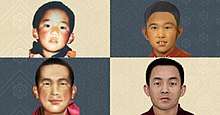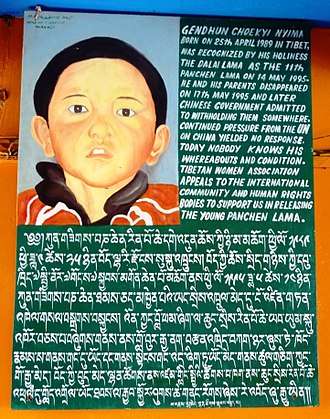11th Panchen Lama controversy
The 11th Panchen Lama controversy is an effort by the Chinese government to dismantle Tibetan Buddhism, through interfering in the reincarnation process of both the Dalai Lama and the Panchen Lama.[1] Considered as living buddhas within the Gelugpa lineage, they are revered reincarnated beings in Tibet, and inherently possess the respect of Tibetans and buddhists abroad. Their traditional monastic seats also include certain amounts of control over parcels of land in Tibet.

Traditionally, the Dalai Lama and the Panchen Lama recognize each other's reincarnations. After the death of the 10th Panchen Lama in 1989, his reincarnation was identified, through traditional Tibetan buddhist methods, as Gedhun Choekyi Nyima and recognized on May 14, 1995, by the 14th Dalai Lama.[2] There is no other process to recognize the reincarnated Panchen Lama.
Three days later on May 17, the Chinese government kidnapped the 6 year old Panchen Lama, and forcibly disappeared him and his family. The Chinese government later promoted its proxy, Gyaltsen Norbu to act as if he were the Panchen Lama. The Chinese government had previously authorized its own search committee process in 1989, involving Tibetan monks under the strict supervision of the Chinese regime. After Gedhun Choekyi Nyima was officially recognized, Bejing began another process to select their proxy.
The criminal controversy stems from the Chinese misunderstanding that reincarnation can be controlled by a government decree. In March 2019, China’s Foreign Ministry said that reincarnation “must comply with Chinese laws and regulations.”[3] When efforts to control the recognition of the 11th Panchen Lama failed in 1995, the Chinese government kidnapped Gedhun Choekyi Nyima.
As of 2020, the Panchen Lama has been held as a political prisoner for 25 years. United Nations committees have opened cases and numerous governments, including the European Parliament, Canada, U.K., and U.S. [4] have repeatedly called to China for the Panchen Lama's release. A 2020 joint petition prepared by 159 organizations spanning 18 countries requests the United Nations to pressure China for the Panchen Lama's release, as well as the release of his family.[5] Chadrel Rinpoche, the Panchen Lama's khenpo, was also arrested in 1995, incarcerated in China, re-incarcerated under house arrest in a Chinese military camp near Lhasa, and reportedly died of poisoning in 2011.[6]

Selection of the Panchen Lama
Three days after the death of the 10th Panchen Lama, the Premier of the State Council published decision on how the 11th Panchen Lama would be selected based on the feedback gathered from the committee of Tashi Lhunpo Monastery and monks, including Chadrel Rinpoche on January 30th 1989. [7][8][9]
Five years after the death of the 10th Panchen Lama, ordinarily, the 11th Panchen Lama would have already been identified.[10] The Nechung Oracle in Dharamsala had been consulted on the matter.[11]
Tibetans would not consider a candidate for the eleventh incarnation legitimate unless he were identified according to Tibetan traditional means, including a search by the tenth's senior staff based on dreams and omens, and formal recognition of the result by the Dalai Lama. On the other hand, the leaders of the Chinese government wanted the process to demonstrate their authority. Beijing planned to have the traditional group of monks follow traditional methods, but to identify a group of candidates, not only one, and then to use the Golden Urn to randomly select one of them, and to exclude the Dalai Lama from the process altogether.[12]
However, Beijing later allowed Tashi Lhunpo Monastery's Chadrel Rinpoche, the head of the search team, to communicate with the Dalai Lama, currently exiled and an opponent of the regime, in hopes that a mutually acceptable process and candidate could be accomplished. At the end of 1994, twenty-five candidates had been identified, and Chadrel Rinpoche sent the Dalai Lama detailed information on all of them; but Chadrel Rinpoche also wrote that all signs pointed to Gedhun Choekyi Nyima as the true reincarnation. In February 1995, the Dalai Lama replied to Chadrel Rinpoche that his own divinations confirmed Gedhun Choekyi Nyima. Chadrel Rinpoche intended to publicly mimic the process that occurred in identifying the tenth Panchen Lama in 1949: the urn would not be used; China would be first to publicly name the choice; and then the Dalai Lama would confirm it. However, in March 1995, Chinese officials insisted on drawing a name from three to five slips in the urn. On May 14, 1995, the Dalai Lama preempted the drawing by publicly announcing that Gedhun Choekyi Nyima was the eleventh Panchen Lama.[13]
In November 1995, the Chinese government selected a different boy, Gyaincain Norbu, using the Golden Urn. This decision was immediately denounced by the Dalai Lama. China holds Gedhun Choekyi Nyima in a place whose location has not been divulged to the public.[14]
In May 1997, Chadrel Rinpoche was sentenced to six years in prison for splittism and betraying state secrets.[15] In 2002 he was released from prison then placed under house arrest, and was reported to have died after a suspicious poisoning in 2011.
References
Citations
- BBC News, "Tibet's Missing Spiritual Leader", 16 May 2005, http://news.bbc.co.uk/2/hi/asia-pacific/4551425.stm
- Central Tibetan Administration, Discovering the New Panchen Lama, 14 May 1995, https://tibet.net/discovering-the-new-panchen-lama-14-may-1995/
- International Campaign for Tibet, "As Panchen Lama turns 30, China must release him and stop interfering in Tibetan religious freedom", 24 April 2019, https://savetibet.org/as-panchen-lama-turns-30-china-must-release-him-and-stop-interfering-in-tibetan-religious-freedom/
- The Statesman, "25 years on, Tibetans still await release of 11th Panchen Lama", 07 May 2020, https://www.thestatesman.com/cities/shimla/25-years-tibetans-still-await-release-11th-panchen-lama-1502889865.html
- David Thomas, Tibet Post International,"159 Organizations Call on UN to Pressure China to Free 11th Panchen Lama of Tibet", 07 May 2020, http://www.thetibetpost.com/en/impact/politics/6763-159-organisations-call-on-un-to-pressure-china-to-free-11th-panchen-lama-of-tibet
- Central Tibetan Administration, "Tibet: Suspicious Death of Panchen Lama Search Leader", 25 November 2011, https://unpo.org/article/13525
- Goldstein 1997, p. 101
- "国务院关于第十世班禅大师治丧和转世问题的决定".
- "第十世班禅大师的圆寂和遗言".
- Hilton 2000, pg. 6
- Hilton 2000, pg. 9
- Goldstein 1997, pp. 100-1
- Goldstein 1997, pp. 102-6
- Goldstein 1997, pg. 109
- Goldstein 1997, pg. 107
Sources
- Goldstein, Melvyn C. The Snow Lion and the Dragon: China, Tibet, and the Dalai Lama (1997) University of California Press. ISBN 0-520-21951-1
- Hilton, Elizabeth. The Search for the Panchen Lama (2000) W. W. Norton & Company. ISBN 0-393-04969-8
- Kuzmin S.L. Management as a tool of destruction. Reincarnation of "Living Buddhas" in modern Chinese legislation. – The Tibet Journal, vol. 42, no 1, pp. 37-48.